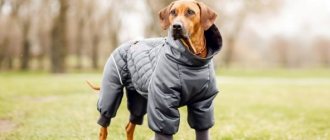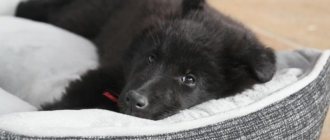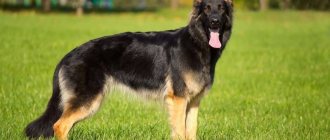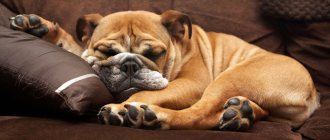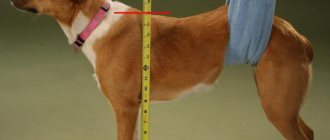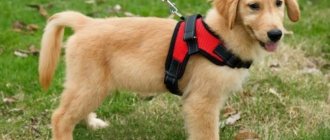Before you run to the store, you need to ask yourself a question: what kind of bed to choose to make your dog comfortable? It is worth making a conscious choice, since the size, shape, material and appearance are different even for dogs of the same size, not to mention different breeds. First, you should study your pet’s habits: how he likes to sleep and rest, whether he likes a soft or harder surface, whether he likes to put his paw under his muzzle, and also find out whether the dog has health problems.
Types of dog beds
Manufacturers, taking care of our little brothers, produce a variety of types of beds.
Rugs
This is the most common, simple and cheap option. It is better to choose rugs from dense and wear-resistant fabric such as corduroy or flock, so that they are filled with hypoallergenic holofiber. It is better to avoid products made of satin or silk that are filled with padding polyester, as such a bed will be uncomfortable for the dog, will quickly deteriorate and is not so easy to wash.
There are double-sided models that are the same on each side, but to prevent slipping on the floor, it is better to choose options with a rubber coating on the bottom. This type is perfect for large or medium-sized long-haired dogs that like to sleep stretched out to their full height.
Beds with sides
High sides protect your pet from drafts and create a feeling of security. Additionally, most pets like to sleep curled up in a ball with their head resting on the side. For smooth-haired breeds, you should choose options from corduroy, velvet and faux fur, as they retain heat well and are pleasant to the body.
For long-haired dogs, it is better to consider smooth models with a soft surface. If the floor in the house is very cold, you should choose products with a rigid wooden or plastic frame. The only disadvantage of this type is its unsuitability in hot weather.
Houses and envelopes
These beds are well suited for small and smooth-haired breeds, as well as for cowardly dogs. The models protect from the cold and create comfort - you can completely crawl into them, hide and be alone. The most common options are with soft upholstery on the inside and a hard frame on the outside.
Despite the widespread prevalence of this option, owners often give preference to beds with rugs: houses and envelopes are difficult to clean and, as a result, begin to smell bad from the inside. In addition, over time, dog fur can wear out in areas that come into closest contact with the walls. In addition to standard soft options, there are plastic models that are closest to the version of a street booth.
Plastic beds
They are a rigid plastic frame with a dense bottom and high edges, inside there is a soft pillow or mattress. You can put a removable cover on the pillow. This bed is very convenient to wash, wash and carry with you. In addition, this type is ideal for animals with urinary disorders and other diseases. Suitable for small and medium breeds.
Mattress
Mostly orthopedic mattresses are used, which are intended for dogs with musculoskeletal problems, spinal injuries, and heavy weight. The spring structure will not allow the mattress to sag under weight and will ensure comfortable sleep and relaxation. These types are easy to wash, as they are often covered with a removable cover on top, and the material itself is water-repellent. They can be used for aged animals that do not move much.
Baskets
The beds are made of natural wicker or plastic, and a soft base is placed inside - bedding or pillow. Well suited for small and miniature dogs. These models of beds are being chosen by more and more owners, since the outer hard frame is very easy to wash, it is easy to fit into the interior, and the pillow does not come into contact with the floor, so it gets dirty less. When purchasing, you should make sure that your pet will not chew such a bed.
Folding beds
Great for travel, trips and outings. They can be folded and taken with you, they are lightweight and do not take up much space. The beds consist of a stable metal frame and dense fabric. The main advantages of choosing this type are that the cot is raised above the ground (so the animal will not freeze), it is stable and easy to clean.
Heated beds
Ideal for cold, short-haired dogs, those who have undergone surgery, those who are sick, as well as for puppies. Well suited for apartments with cold floors and traveling in cold conditions. The bed consists of two parts - a mattress made of water-repellent material and a heating mat. The heating element operates at low voltage, so this bed is completely safe for your pet. If necessary, the mattress can be easily washed in a washing machine by first removing the heating mat.
Sofas
An ideal option for beds for those who like to relax on a large sofa with the owner. The interior of this sofa consists of an orthopedic memory foam mattress, which ensures correct sleeping position, support for the animal’s body, and reduces the load on the joints and spine. The side sides are filled with holofiber and serve as an excellent pillow for the dog. This option is suitable for medium and large individuals.
Loungers with a hood
The model consists of a soft base with small sides and a “hood” made of dense soft fabric on top. This design is suitable for dogs that like to sleep under a blanket, toy dogs, and smooth-haired breeds. A mink blanket perfectly protects against drafts and cold, ensuring a restful sleep at night. The hood can be easily removed and washed in a washing machine, and the base can be vacuumed and wiped with a damp cloth.
Sizes and shapes
The size of the model will directly depend on the size of the pet. If the dog likes to sleep stretched out, then you should take a bed that is 5–10 cm larger than the size of the dog itself. If it prefers to sleep in a ball, the bed should be 10–15 cm larger on each side. You should not buy products for growth, as puppies will feel uncomfortable in a sleeping area that is too large. The height of the sides should be selected according to the height of the animal - they should not be higher than the dog’s neck.
To begin with, it is recommended to measure your pet while resting or sleeping - from the muzzle to the tail, and if the animal likes to stretch its paws forward while sleeping, then you also need to take into account the length of the paws. Large dogs need a larger bed, while small dogs often sleep curled up in a ball and, as a result, need a smaller bed.
There are standard sizes that are designed for specific breeds. However, if necessary, the bed can be made to order, indicating the required parameters and dimensions.
- 50x40 cm – small breeds: lap dogs, spitz dogs, toy terriers, Pekingese, Chihuahuas, Yorkshire terriers.
- 70x50 cm – small and medium-sized breeds: pugs, dachshunds, bulldogs, Jack Russells, French bulldogs, Boston terriers, Scottish terriers.
- 90x60 cm – medium-sized breeds: corgis, beagles, cocker spaniels, English bulldogs, basset hounds, whippets, fox terriers, foxhounds.
- 110x70 cm – large breeds: shepherds, Labradors, mastiffs, Dobermans, collies, retrievers, bull terriers, huskies, Irish setters.
- 120x80 – for very large dogs: wolfhounds, Great Danes, Cane Corsos, English mastiffs, Newfoundlands.
Forms can be very diverse, depending on the manufacturer. The most popular are classic square, round and oval. For dogs that stretch out while sleeping, it is better to choose rectangular and square ones, and for those who like to curl up, it is worth taking round and oval ones. The shape of the houses can be very diverse and sometimes look more like children's toys - cars, fish houses, birdhouses.
The color of the beds is completely unimportant for pets, but for owners it is often decisive. It is better to choose a model with fabric that matches the color of the animal, so that the fur does not contrast too much and is not so noticeable. If you wish, you can always buy or sew a cover of a different color.
What's better than a house?
Usually dog owners have to make their choice between beds and houses. What is better than the first option and why should the second be chosen only for the most picky pets? Any animal above 25 cm at the withers will feel quite uncomfortable in a confined space . If the pet is also physically active, the owner will regularly find its refuge in the most unexpected places of the house or apartment.
The difficulty of hygienic care is another reason for refusing to buy a house. If the bed is easy to disinfect, treat with steam, or simply change the cover on it, then rigidly fixed upholstery will not allow such liberties. As a result, over time the home will emit a rather unpleasant odor. It is also not very beneficial for the animal's fur to be in a tight space - it can be wiped off in areas in contact with the walls.
This is why owners of show animals prefer bedding and beds without a roof.
What material to choose for beds?
When choosing a sleeping place for a dog, it is important to know whether your friend is allergic to certain materials and fabrics, so it is advisable to consult a veterinarian before purchasing.
- When choosing, you should pay attention to models made of durable, dense natural fabrics - corduroy or flock
. These types of beds are easy to clean, dry quickly, are resistant to damage, and hair does not stick to them. However, not all natural fabrics are equally good - chintz and calico are completely unsuitable, as they wear out quickly and lose their shape and color after just a few washes. - Cheap synthetic fabrics
are often used to make a lounger cheaper. Such models can last a little longer, but they are inconvenient for both the pet and the owner - a lot of hair sticks to the fabrics, it is slippery and electrified, often hitting the animals in the nose. - Dogs with a small amount of hair are very fond of materials with long pile - plush and artificial wool
. For long-haired dog breeds, this type of bed is not recommended, as hair sticks to these surfaces. - When choosing baskets, you should give preference to natural materials
(willow vine or rotunda) - they are hypoallergenic, do not have a strong odor and are harmless to the animal.
The sides of dog beds should be quite dense. It is better to choose models with a rigid frame, since soft sides can quickly settle and lose their main function.
It is advisable to choose hypoallergenic holofiber
, not padding polyester. It will provide warmth to your pet, and in addition, unpleasant odors are not absorbed into this material and parasites are not colonized.
Furniture foam rubber is suitable for flat bedding and mattresses, as it holds sufficient volume and does not sag under the weight of the animal. You should not choose natural fillers (fluff, feathers), as they can become a breeding ground for various parasites.
Selection rules
There are certain rules for purchasing a dog bed. First of all, it is worth considering the following points.
- Dimensions of the animal. For an adult dog, you should purchase the most spacious bed on which it can stretch its paws. If we are talking about a puppy, there are two options for the development of events. For large breeds, it is recommended to first purchase a “children’s” version, with a fairly soft base, and then a full-fledged adult bed. For small and medium-sized dogs, it is better to immediately choose a bed for growth or buy a transforming model with variable dimensions.
- Practical and easy to maintain design. The soft part of the bedding should be made of hypoallergenic fabric, fairly dense, washable; it is better to choose artificial down as a filler. A high-quality product has an additional antistatic effect. The plastic or wooden frame should repel water, eliminating the presence of sharp parts that could injure the pet.
- Color spectrum. Beds for small breeds of dogs are often painted in the most unimaginable colors. The pet itself is indifferent to this point, but the owner should take into account that on light-colored material, stains, drops of saliva, and traces of dirty paws will be very noticeable. If a dark bed doesn’t look pretty enough, you can simply sew a few bright replacement covers for it.
- Convenience. Owners often strive to choose a bed for a small dog in the form of a full-fledged house, but the pet feels much more comfortable in containers that look like baskets - with an open top. Products with sides have their own characteristics - an accumulation of dirt and dust forms in the layer between the base and the soft liner. It will have to be carefully removed by hand every time you clean it.
- Degree of openness. Short-haired pets will prefer more closed models with a voluminous soft mattress. Dogs with long hair most often choose to sleep the simplest beds without sides, on which they can lie with their paws outstretched.
- Price. Even a homemade option won’t be too cheap. It’s also better not to skimp on a purchased bed. It must be made of high quality materials - modern and safe. You should avoid purchasing brightly colored products - they may fade.
How to care for a dog bed
Periodic cleaning of the sleeping area is the key to the health and comfortable sleep of your four-legged friend. Without proper care, an unpleasant odor, stains, and parasites may appear, which can lead to the dog refusing to sleep in the bed.
Models with removable covers are the easiest to clean - just wash the cover in a washing machine at a temperature of 30–40C once every 2-3 weeks
. Wool can be easily collected with a vacuum cleaner or damp cloth.
The soft base and mattress can be vacuumed, wiped with a rag, and if heavily soiled, wash in a machine with an additional spin cycle. Preventive treatment with an antiparasitic spray should be carried out once a month.
It will be enough to wipe the hard frame with a damp cloth once every 3-4 weeks. To eliminate unpleasant odors, you can use a neutralizer.
Beds without removable covers, mattresses, rugs need special care: they are recommended to be dry cleaned once every 1-2 months
for quality cleaning.
It is important to remember that you need to care for more than just your sun lounger. In the room where the bed is located, you need to carry out dry cleaning every day and wet cleaning weekly. Washing powder should be hypoallergenic and without a strong odor. If it is not possible to buy a special powder for dogs in a specialized store, then you can use a baby powder.
Choosing a bed is not always an easy task, so you can turn to specialists. In any of the stores where GiGwi products are available, you can buy a high-quality bed for your pet - according to your taste and the appropriate price. The store staff will tell you which bed to choose for a dog of a certain breed, so that it matches the character of the animal.
Peculiarities
Giving your dog his personal territory is an important aspect of raising an animal. It is important to choose a comfortable and high-quality bed that suits your pet and place it correctly. If you follow these principles, your dog will have a place where he will feel comfortable and safe and can take a break from people. This will also provide comfort to the owner, since the dog will know where to go after a specific command from the owner.
Where to place
If possible, place the bed in the area where your dog sleeps most often. If this is difficult, then when choosing a location, use the following tips:
- This should be a secluded place where household members rarely go; but the dog must observe the movements of people in this room.
- Place the lounger at a height of at least 8 - 10 cm from the floor to avoid drafts.
- Avoid batteries, electrical appliances, air conditioners, doors and windows.
- You may need to place several sun loungers in different rooms.
How to train a dog
Small puppies are easiest to train to a bed. After active games and food, when the puppy is about to sleep, take him to the bed and say “Place,” thereby marking his territory. With older dogs it can be a little more difficult, but if you place the bed in the dog’s usual place for sleeping, then there should be no problems.
The main rule: never scold the dog when it is on the bed . “Place” is an inviolable zone where the animal should feel protected and know that it will not be exposed to danger. Also, never occupy your dog's bed with other things. Even for a while. Don't allow other animals to be there. “Place” is the territory of only one dog.
Care
It is necessary to clean the “place” at least once a month, preferably more often. If it seems to you that the bed is clean, this does not mean that there are no parasites invisible to the eye. If the type of bed allows it, use replaceable covers (you can sew them yourself or purchase them). Steam, vacuum or wash your dog bed periodically. Special bactericidal sprays are also sold that will get rid of unpleasant odors and disinfect the sunbed.
